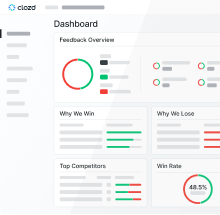In today's dynamic and fast-paced business environment, understanding your market has never been more essential. Success hinges not just on having a great product or service, but also on truly knowing your audience, recognizing emerging trends, and adapting to ever-changing demands. Market research plays a key role in helping companies accomplish these goals by providing the necessary insights to shape strategies, inform product development, and ensure that initiatives resonate with target audiences.
But the questions remain: how can organizations harness the full potential of their existing resources—particularly their CRM contacts—to drive smarter market research? And how can advanced approaches further expand the value of these efforts? This comprehensive guide delves into the full spectrum of Market Research Methods available to organizations today and explores in detail how leveraging CRM contacts, combined with innovative approaches like those offered by Clozd, can unlock powerful business growth.
What is Market Research?
Market research is a systematic process designed to collect, analyze, and interpret data relevant to a specific market, industry, or audience segment. It encompasses investigation into customer needs, attitudes, and behaviors; competitor strategies and performance; and broader industry trends and regulatory shifts. The insights collected through this process help organizations create solutions aligned with customer expectations, mitigate unforeseen risks, identify untapped opportunities, and ultimately drive informed decisions at every level of the business.
Traditionally, market research included methods such as field studies, focus groups, and data analysis of public reports. Today, it increasingly incorporates the digital footprints recorded in CRM platforms—rich repositories of interactions, demographic details, and purchase histories. By integrating these modern data sources, companies are empowered to gain nuanced, actionable insights into customer lifecycles and shifting preferences.
The Value of Market Research
Comprehensive market research provides numerous benefits, serving as the foundation for sound strategic decision-making:
- Informed Decision-Making: Market research eliminates guesswork by offering concrete data that leaders can use to craft strategies, allocate resources, and set priorities.
- Competitive Advantage: Insight into market movements, competitive behavior, and consumer sentiment allows businesses to anticipate changes and stay ahead of rivals.
- Customer Understanding: Deep dives into customer preferences, expectations, and pain points enable organizations to build solutions and communication that genuinely resonate.
- Risk Mitigation: Research helps stakeholders identify risks, from shifting technologies to changes in regulation or consumer behavior, enabling proactive mitigation.
- Opportunity Identification: Early detection of market gaps, underserved segments, and emerging trends paves the way for innovative products, services, and campaigns.
- Efficient Resource Allocation: Data-driven understanding helps focus investments in the most promising or high-impact areas, delivering stronger returns.
The benefits of effective market research can be seen across sales, marketing, customer service, product innovation, and executive decision-making—fuelling growth at every stage.
Market Research Methods
Market research encompasses a broad range of techniques, each designed to answer specific business questions and provide unique types of insight. Understanding which methods to use, and how to combine them, is essential to building a complete picture of the market landscape:
1. Primary Research
Primary Research is designed to collect original data straight from the source. This approach is proactive, with businesses going directly to customers, industry experts, or stakeholders to fill knowledge gaps. Techniques include:
- Surveys: Questionnaires—delivered by email, phone, in-person, or online—gather structured feedback from targeted segments. Surveys are valuable for capturing both quantitative data and qualitative feedback through open-ended questions.
- Interviews: One-on-one conversations dive deep into individual perspectives, revealing motivations, expectations, and pain points often missed in broader survey formats.
- Focus Groups: Facilitated group discussions provide nuanced insights into consumer opinion and group dynamics around products or campaigns.
- Field Trials & Observations: Real-world testing of new products or concepts allows organizations to see firsthand how customers react in natural settings.
Primary research is especially valuable when a business seeks personalized, current, or context-specific insights unavailable through published sources.
2. Secondary Research
Secondary research, sometimes referred to as “desk research,” examines information that has already been collected, published, or reported by others. This type of research includes:
- Market Reports: Industry studies, white papers, and analyst reports provide overviews of market size, trends, forecasts, and benchmarks.
- Academic Studies: University and scholarly research can lend depth to topics ranging from economics to behavioral psychology.
- Company Data: Annual reports, press releases, financial filings, and competitor websites can shed light on rival moves, growth rates, and business models.
- News Outlets & Trade Publications: Continuous industry coverage keeps organizations attuned to new entrants, regulatory changes, and thought leadership.
Secondary research is often the starting point for understanding the macro-environment, establishing baselines, or validating primary research findings.
3. Qualitative Research
Qualitative research sets out to discover the “why” and “how” behind individual behaviors. Rather than focusing on statistical measurement, it captures emotions, experiences, and attitudes. Common qualitative methods include:
- In-depth Interviews: Participants delve into motivations, beliefs, and decision-making criteria through guided conversations.
- Focus Groups: Group dynamics lead to the emergence of consensus and dissent, revealing group attitudes and social triggers.
- Observational Studies: Researchers study authentic consumer behavior in natural settings, capturing details often lost in self-reported data.
- Open-ended Surveys: Written responses encourage participants to share thoughts in their own words.
Qualitative research is indispensable for early-stage product development, branding, and understanding user journeys at a granular level.
4. Quantitative Research
Quantitative Research seeks to measure attitudes, behaviors, or outcomes through numerical data and statistical analysis. It is critical for evaluating hypotheses at scale. Common techniques include:
- Structured Surveys: Fixed-choice questions across large groups yield results that can be aggregated and analyzed statistically.
- Customer Analytics: Web analytics, CRM data, and purchase histories allow measurement of conversion rates, retention, and other key metrics.
- A/B Testing: Comparing the performance of different versions of a product, webpage, or campaign to determine what works best.
Quantitative techniques are ideal for tracking shifts over time, benchmarking performance, and making predictions based on statistical models.
Leveraging CRM Contacts for Market Research
While traditional methods remain fundamental, one of the most powerful—and often underutilized—resources available to businesses today is their CRM (Customer Relationship Management) platform. A CRM system captures rich data trails: every customer interaction, transaction, inquiry, and feedback point. Harnessing this information can revolutionize your market research efforts in several key ways:
1. Segment Your Contacts
Effective market research begins with segmentation. Using your CRM, categorize contacts according to a variety of criteria, such as:
- Demographics: Age, gender, career stage, geographic location, etc.
- Firmographics: Company size, industry, revenue, or region for B2B businesses.
- Behavioral Data: Purchase history, frequency of engagement, response to previous campaigns.
- Engagement Levels: Activity score, open rates, event participation.
Tailoring research to each segment ensures higher response rates, richer feedback, and more actionable insights. For example, feedback from high-value customers may differ materially from first-time buyers or prospects at different points in the sales funnel.
2. Conduct Surveys and Interviews
Your CRM holds updated contact information, making it easy to invite targeted groups to take part in surveys, interviews, or focus groups.
- Personalized Outreach: Leverage CRM automation tools to customize invitations and reminders, boosting participation.
- Integrated Responses: Many CRM platforms allow survey links and results to be captured directly within the customer profile, streamlining analysis.
- Longitudinal Studies: Ongoing research initiatives can track how responses evolve over time, especially as customer relationships mature.
By directly engaging your existing base, you ensure research insights are rooted in real-world experiences and requirements.
3. Analyze Customer Interactions
CRMs capture a multitude of touchpoints—emails, phone calls, site visits, purchases, support tickets. Analyzing these interactions can reveal hidden patterns and valuable trends, such as:
- Common Pain Points: Recurring issues flagged in support conversations.
- Decision Triggers: Actions or messaging that lead to conversions, upgrades, or repeat purchases.
- Churn Signals: Early warning signs—such as declining engagement or lengthy resolution times—that indicate heightened risk of customer loss.
Mining customer interaction data helps to move beyond surface-level observations, providing a comprehensive view of the customer journey.
4. Validate Messaging and Positioning
CRM contacts serve as an ideal focus group to test new branding, messaging, or offers:
- A/B Tests: Segment contacts and expose each group to different messages, observing which drives better engagement or conversion.
- Feedback Loops: Solicit detailed opinions on value propositions, product descriptions, or website copy.
- Persona Refinement: Compare engagement and response rates across different segments to continually refine buyer personas.
This iterative approach ensures all external messaging aligns with true customer preferences and values.
5. Map the Full Customer Journey
By aggregating touchpoints across the sales and support lifecycle, CRM data can be visualized to highlight friction points, repeatable success patterns, and opportunities for enhanced engagement—critical for refining processes and improving overall customer satisfaction.
How Clozd Enhances Market Research
While CRMs hold a wealth of data, organizations often struggle to translate raw information into actionable strategic insights. This is where Clozd takes market research to the next level, using advanced methodologies to extract authentic customer perspectives and provide a more comprehensive, nuanced understanding of market realities.
Clozd specializes in capturing the unfiltered, candid feedback of buyers and customers through expert-led interviews and analysis, bridging the gap between quantitative CRM data and qualitative insight. Here’s how Clozd empowers organizations to go deeper:
1. Win-Loss Analysis
Traditional sales data might reveal what happened in a given opportunity, but Clozd uncovers the why. By conducting thorough interviews with recent buyers—regardless of outcome—Clozd provides:
- Deep Motivations: Real-world reasons contributing to successful deals or missed opportunities.
- Competitive Intelligence: Honest comparisons with rival offerings and the perceived strengths or weaknesses that shaped decisions.
- Sales Process Optimization: Clarity around which stages of the pipeline require adjustment or support.
These insights enable organizations to refine targeting, strengthen sales enablement, and align teams around the most effective strategies.
2. Customer Experience Feedback
Clozd enables ongoing monitoring of customer sentiment through structured conversations:
- Voice of the Customer: Understand how clients perceive products, services, and overall experiences.
- Lifecycle Feedback: Capture input at key milestones—from onboarding and usage to renewal and expansion—to ensure satisfaction and promote loyalty.
Continuous feedback allows your team to proactively address concerns, celebrate wins, and continuously improve processes.
3. Retention & Churn Analysis
Losing customers is costly. Clozd helps organizations delve into the core reasons behind customer departures:
- Churn Triggers: Uncover specific events or perceptions that commonly precede cancellations.
- Retention Opportunities: Learn which touchpoints foster deeper loyalty and what measures can be taken to enhance customer stickiness.
- Strategic Action Plans: Translate feedback directly into actionable initiatives to reduce attrition and extend customer lifetime value.
These insights don’t just reduce churn; they turn at-risk accounts into lasting advocates.
4. Product Research
Clozd empowers organizations to innovate with confidence:
- Roadmap Prioritization: Identify which features or improvements are most urgently desired by your target market.
- Usability Insights: Uncover issues that may hinder adoption or satisfaction.
- Market Fit Validation: Ensure your product is aligned with customer needs, making new launches smoother and more successful.
Leveraging this customer-driven intelligence ensures every iteration moves your solution closer to market leadership.
The Clozd Advantage
By combining advanced interview techniques, expert analysis, and the integration of findings with your existing CRM and business intelligence platforms, Clozd delivers:
- Authentic Insights: Unlike anonymized datasets or inference-based analytics, Clozd delivers raw, honest feedback straight from buyers and customers.
- Actionable Data: Every insight is connected to concrete recommendations and business outcomes, empowering teams to drive measurable change.
- Competitive Edge: Tap into the real drivers of customer behavior—what actually influences decision-making—and build strategies competitors can’t match.
- Comprehensive Integration: Findings can be presented in a format aligned with your organization's workflow, ensuring insights are immediately actionable by sales, marketing, and product teams.
- Continuous Improvement: Ongoing access to updated insights means your organization can quickly pivot and stay ahead of market shifts.
Conclusion
Market research stands as the cornerstone for understanding your customers, competitors, and the industry at large. The integration of CRM data into research strategies allows organizations to build nuanced, real-time portraits of their markets and act with confidence. By segmenting contacts, gathering and analyzing feedback, and validating approaches with real-world insights, companies maximize their understanding and impact.
Augmenting CRM-based research with Clozd’s expert-led feedback mechanisms unlocks an even deeper level of understanding—illuminating not just what customers did, but why they made those choices, how they feel about their experiences, and where you can grow stronger.
For organizations aiming to accelerate growth, improve retention, and outpace competitors, there has never been a better time to harness the combined power of CRM data and Clozd’s advanced market research methodology. Discover new opportunities, optimize performance at every stage of the customer journey, and make the confident, insight-driven decisions that define industry leaders.
Ready to see what Clozd can reveal about your market? Explore our in-depth guides, success stories, and demos—and unleash the power of authentic customer insights to transform your business strategy moving forward.











.svg)












.svg)

.svg)




